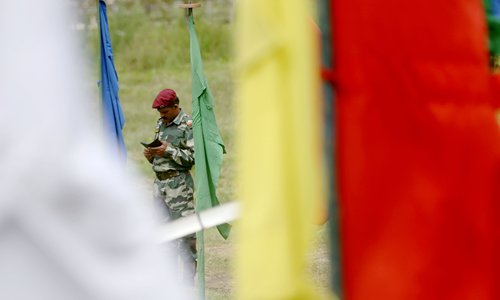Quickie
Colonel
Why is India unnecessary risking a war?
Commentary: India to face the consequences of its strategic miscalculation
BEIJING, Aug. 25 (Xinhua) -- It has now entered the third month since Indian military trespassed into Chinese territory, to which China has shown the utmost tolerance. India must take any possible consequences if it continues to miscalculate the situation.
On June 18, over 270 armed Indian troops with two bulldozers crossed the eastern boundary into Doklam, China's sovereign territory, to obstruct Chinese infrastructure construction.
It is a double standard, as India has approved the building of a military road to facilitate troop deployment near the western part of China-India border to "ensure the strength of the Indian border troops."
On Aug. 22, Chinese troops, patrolling on the Chinese side of Pangong Lake, suffered injuries from the reckless actions of Indian troops, which once again reflected India`s insincerity and self-contradictions in resolving the Sino-India border issue peacefully.
A senior Indian official has said that the country has not attacked any other country and has no ambition to expand its boundaries.
However, the Indian military has trespassed over the mutually recognized boundary that has been abided by both sides for nearly 130 years and its troops remain on Chinese territory.
China has proved its sovereignty of Doklam to the international community with convincing evidence, including the historical convention from 1890.
Meanwhile, China has not closed the door to diplomatic dialogue with India to ease tensions.
Since the 1960s, through negotiation and consultation, China has delimited 20,000 kilometers of land boundary and is in complete accord with 12 out of its 14 land neighbors.
"India thinks that the international situation is good enough for it to test China's bottom line," Li Qingyan, an expert on South Asia issues at China Institute of International Studies, told Xinhua.
But India may have miscalculated China's stance in defending its sovereignty. China's bottom line is the border line, as shown in the Sino-Indian border conflict in 1962.
China values peace and the interests of innocent people on both side of the border, that is why it has remained patient in the face of such encroachment.
China has never made the first move in wars fought since 1949 but it would not flinch if a war were to be inflicted upon its people.
The prerequisite for settlement of the border standoff is the unconditional withdrawal of all trespassing personnel and equipment to the Indian side.
China has sent this message openly to India through many channels over the past 60 days.
Now, it is time for India to abide by the law, respect historical facts, to match words with deeds and make the wise decision based on reasonable strategic calculation.
China and India are two developing giants with a wide range of common interests. A sensible bilateral relationship will benefit more than two billion people, nearly one-third of the global population.
The ball has been placed in India's court.
Commentary: India to face the consequences of its strategic miscalculation
BEIJING, Aug. 25 (Xinhua) -- It has now entered the third month since Indian military trespassed into Chinese territory, to which China has shown the utmost tolerance. India must take any possible consequences if it continues to miscalculate the situation.
On June 18, over 270 armed Indian troops with two bulldozers crossed the eastern boundary into Doklam, China's sovereign territory, to obstruct Chinese infrastructure construction.
It is a double standard, as India has approved the building of a military road to facilitate troop deployment near the western part of China-India border to "ensure the strength of the Indian border troops."
On Aug. 22, Chinese troops, patrolling on the Chinese side of Pangong Lake, suffered injuries from the reckless actions of Indian troops, which once again reflected India`s insincerity and self-contradictions in resolving the Sino-India border issue peacefully.
A senior Indian official has said that the country has not attacked any other country and has no ambition to expand its boundaries.
However, the Indian military has trespassed over the mutually recognized boundary that has been abided by both sides for nearly 130 years and its troops remain on Chinese territory.
China has proved its sovereignty of Doklam to the international community with convincing evidence, including the historical convention from 1890.
Meanwhile, China has not closed the door to diplomatic dialogue with India to ease tensions.
Since the 1960s, through negotiation and consultation, China has delimited 20,000 kilometers of land boundary and is in complete accord with 12 out of its 14 land neighbors.
"India thinks that the international situation is good enough for it to test China's bottom line," Li Qingyan, an expert on South Asia issues at China Institute of International Studies, told Xinhua.
But India may have miscalculated China's stance in defending its sovereignty. China's bottom line is the border line, as shown in the Sino-Indian border conflict in 1962.
China values peace and the interests of innocent people on both side of the border, that is why it has remained patient in the face of such encroachment.
China has never made the first move in wars fought since 1949 but it would not flinch if a war were to be inflicted upon its people.
The prerequisite for settlement of the border standoff is the unconditional withdrawal of all trespassing personnel and equipment to the Indian side.
China has sent this message openly to India through many channels over the past 60 days.
Now, it is time for India to abide by the law, respect historical facts, to match words with deeds and make the wise decision based on reasonable strategic calculation.
China and India are two developing giants with a wide range of common interests. A sensible bilateral relationship will benefit more than two billion people, nearly one-third of the global population.
The ball has been placed in India's court.

